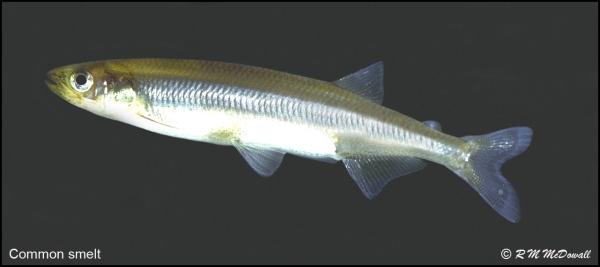Smelt have a distinctly forked tail and a strong cucumber smell.
Common name: Common smelt Scientific name: Retropinna retropinna Māori names: includes pōrohe and paraki
About this species
The common smelt is a widespread indigenous freshwater fish. It is common in the North Island, but not in the South Island. One other member of the family Retropinnidae, Stokellia anisodon (Stokell's smelt), is present in a small region of the South Island. Smelt are elongated, small, silvery fish that occur in freshwater as far upstream as they are able to migrate, as well as in coastal seas and estuaries. Smelt are considered to be poor climbers with a restricted ability to penetrate very far inland.
In freshwaters there are many diadromous as well as river and lake resident populations. Sometimes these populations were established as a result of human introductions to serve as food for trout. Because there are few release records, it is hard to determine which populations are naturally land locked and which have been introduced into lakes. Diadromous smelt spawn during autumn/winter on sand bars of lower river reaches. Larval stages inhabit coastal marine waters, and the post-larvae and immature stages re-enter rivers and some lowland lakes.
Smelt are highly sensitive to being removed from the water and handled, with these activities often resulting in rapid death. Of note is the strong cucumbery smell that smelt have.
Traditional knowledge
Smelt were usually captured in seine nets, scoop nets, or hīnaki. Fish were both eaten immediately and preserved to be eaten at a later date. Fish could be preserved by steaming or sun drying.
They are a major component of the whitebait fishery in some areas and comprise important customary fisheries (e.g., Waikato River, Te Arawa Lakes and Lake Taupō).
Impacts on smelt
Dams at low elevation or on low gradient waterways may prevent access to quality habitat. Although smelt are not strong upstream migrants, they can be found up to 300 km inland and at up to 2000 m altitude.
Smelt are very sensitive to handling and stress. Smelt like cooler temperatures between 15°C and 17°C although they are able to cope with temperature increases up to approximately 27°C. They seem to prefer slightly alkaline waters with a pH of 8-9. Smelt appear to prefer low levels of sedimentation with lower smelt populations in lakes that have high levels of siltation.
In laboratory experiments, smelt were the most sensitive native fish to low dissolved oxygen levels below 3 mg/litre. Natural pollutants such as ammonia, which occurs in livestock waste and poorly treated wastewater, can adversely affect fish populations through displacement and, at high concentrations, death. Common smelt were found to be the fourth most sensitive species tested to ammonia toxicity.
References and Further Reading
Find papers relevant to all Aotearoa freshwater fish on our reference page
Smelt, pōrohe
- Rowe, D. K., Taumoepeau, A. 2004. Decline of common smelt (Retropinna retropinna) in turbid eutrophic lakes in the North Island of New Zealand. Hydrobiologia 523: 149-158.
- Ward, F. J., Northcote, T. G., Boubée, J. A. T. 2005. The New Zealand common smelt: biology and ecology. Journal of Fish Biology 66: 1–32.

